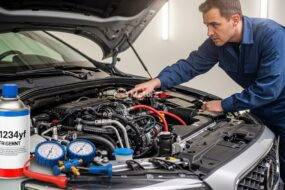Heater Core Problems Signs and fixes for heater core issues. The heater core is a crucial component of your vehicle’s heating system, responsible for keeping you warm and comfortable during cold weather. When heater core problems arise, they can significantly impact the efficiency of your heating system and, consequently, your driving experience. In this article, we will explore the signs of heater core issues and provide insights into the possible fixes to help you address these problems effectively.
Understanding the Heater Core
Heater Core Before delving into the signs and fixes, it’s essential to understand the role of the heater core in your vehicle’s heating system. The heater core is a small radiator-like unit located under the dashboard. It is connected to the engine cooling system and works by circulating hot coolant through its tubes. As air passes over the heated core, it warms up and is then blown into the vehicle’s interior, providing warmth to the passengers.
Insufficient Heat:
One of the most apparent signs of a heater core issue is a lack of sufficient heat in the cabin. If you find that the air blowing from the vents is not as warm as it used to be, it could indicate a problem with the heater core. A malfunctioning heater core can result in excess condensation inside the vehicle, leading to foggy windows. If you notice persistent fogging, even when the weather isn’t particularly humid, it might be a sign of a heater core problem.
Sweet Smell Inside the Car:
A leaking heater core can release coolant vapor into the cabin, producing a sweet, distinctive odor. If you detect this scent while driving, it’s crucial to address the issue promptly. Puddles of coolant forming on the passenger side floorboard are indicative of a leaking heater core. This can lead to a loss of coolant, potentially causing engine overheating and other serious issues. Unusual noises, such as gurgling or bubbling sounds, coming from the heater may signal air pockets or blockages within the heater core. These issues can hinder the proper circulation of coolant.
Flush the Heater Core:
Over time, the heater core can accumulate debris and sediment, reducing its efficiency. Flushing the heater core involves removing these deposits by forcing clean water or a specialized cleaning solution through the core. This process can improve heat circulation and address issues related to clogs.
Check and Replace Coolant:
Regularly checking and maintaining the coolant in your vehicle is crucial for the proper functioning of the heater core. Low coolant levels or coolant that is old and contaminated can lead to heater core problems. Ensure that the coolant is at the recommended level and replace it according to the manufacturer’s guidelines.
Inspect and Seal Leaks:
If you identify a coolant leak in the heater core, inspect the unit for visible damage. Small leaks can sometimes be sealed using commercial products designed for this purpose. However, it’s important to note that larger or more severe leaks may require professional repair or heater core replacement.
Bleed the Cooling System:
Air pockets in the cooling system can hinder the flow of coolant to the heater core. Bleeding the system involves removing these air pockets to ensure proper circulation. Refer to your vehicle’s manual for specific instructions on how to bleed the cooling system. In cases of extensive damage or irreparable leaks, heater core replacement may be necessary. This is a complex and time-consuming task that often requires professional expertise. Consider consulting a qualified mechanic to ensure a proper and effective replacement.
Conclusion
Heater Core Problems can significantly impact the comfort and functionality of your vehicle’s heating system. Recognizing the signs of these issues and addressing them promptly is crucial for maintaining a comfortable driving experience, especially during colder seasons. Whether it’s a simple flush, coolant replacement, or more extensive repairs, taking the necessary steps to resolve heater core problems will contribute to the overall health and performance of your vehicle. If in doubt or if issues persist, seeking professional assistance is always advisable to ensure a thorough and accurate resolution of the problem.





